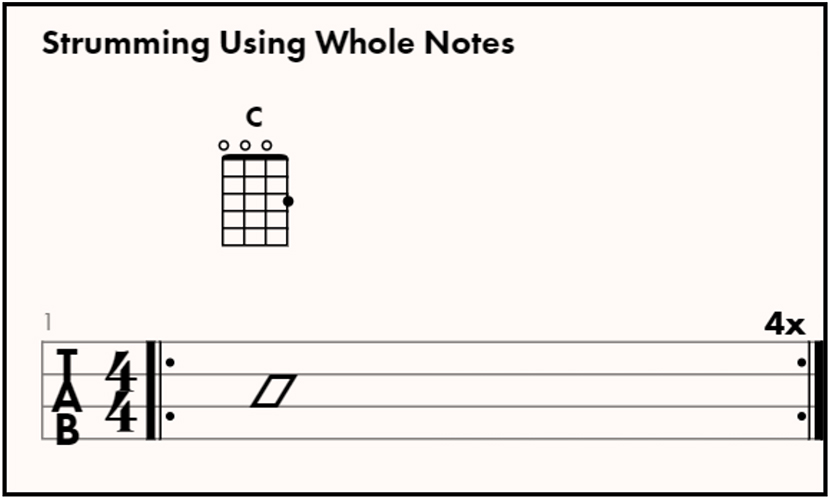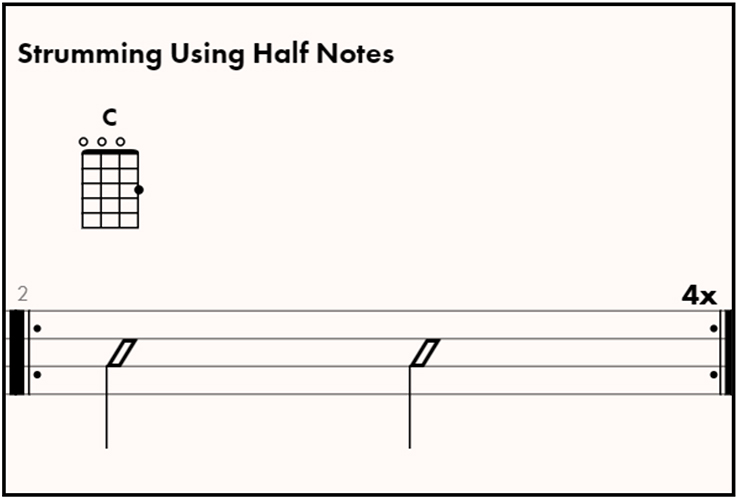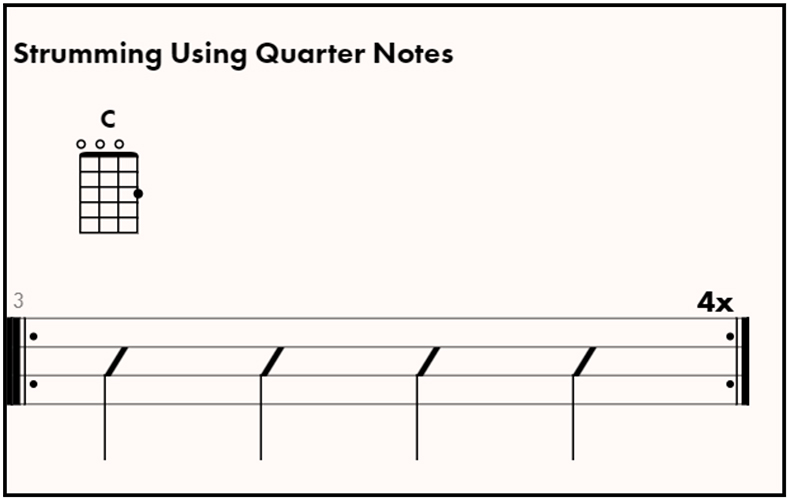5 Min ReadBy Ben Nemeroff
How to Strum a Ukulele for Beginners
Interested in learning how to strum a ukulele? Whether you're strumming with your fingers or a pick, learn how to master ukulele strumming patterns today.

Sections
Learning to play songs and chords on your ukulele is one way to measure your progress. However, learning how to strum your ukulele is a fundamental building block of your practice that factors into playing songs and learning new chords. Ukulele strumming helps you develop a feel and a rhythm for every chord you play, and observe patterns as to how chords sound within songs based on just how you strum those chords.
While there are many reasons to learn to play ukulele, its nylon strings make it an ideal instrument for users to pick up and play with minimal pain or pressure on your fingertips when transitioning between chords and strumming. Not sure where to start? We’ll walk you through some techniques to help perfect your ukulele strumming technique and some tips for using your pick or your fingers to strum your uke.
Lesson: How to Strum a Ukulele
One of the fundamental pillars of learning to play ukulele is playing chords and learning proper strum technique. However, as is the case with learning any instrument, you have to learn to walk before you can run. Before we talk about how to strum a ukulele, strumming patterns and techniques, let’s take a look at learning to tune your ukulele and playing chords.
Learn to Tune Your Ukulele
Before you start learning chords and strumming patterns, you’ll first want to learn how to tune your ukulele. The four strings of your ukulele are tuned as follows:
• G = The fourth string • C = The third string (lowest-tone string) • E = The second string • A = The first string (highest-tone string)
What makes the tuning on a ukulele unique is that, unlike a guitar or bass, the lowest-toned string on a ukulele is actually the third string. On a guitar or bass, the strings are tuned in descending order. This arrangement of strings is part of what gives the ukulele its bright, cheerful tone and is a key consideration when forming chords with your fingers and listening to the tone of each chord.
To get your ukulele in-tune, check out the free Fender Tune app.
Playing Chords on the Ukulele
Chords are a combination of three (and sometimes four) different notes that are played together, forming a distinct sound. Chords are made up of specific formulas of notes and provide the building blocks for playing some of your favorite songs.
While the notes that make up each chord will remain the same regardless of whether you’re playing a C major chord on either a ukulele or a guitar, the finger patterns used to play those chords differ between the two instruments.
Familiarize yourself with the many different ukulele chords and start learning some of the most popular chords, one by one. Once you are able to perfect your technique and accurately place your fingers on the right positions on your fretboard for different chords for a crisp, clean sound, you’ll be ready to experiment with different strum patterns and techniques!
Developing Good Ukulele Strumming Habits
When it comes to strumming your ukulele, it’s all in the wrist! Keep your wrist loose when strumming your strings. You can hear the difference between playing with a loose, fluid wrist versus a rigid wrist. Keeping your wrist loose can allow you to lean more intuitively into strumming patterns and allowing the chords to flow more naturally than they would if your strumming hand was more rigid.
Posture is also important to developing proper ukulele strumming habits. Sit up straight so that your strum hand can move freely while your fretting hand can comfortably work its way up and down the neck of your ukulele.
You can strum your ukulele in a variety of ways:
• Thumb: This is the most common way to strum your ukulele, using your thumb to fluidly strike your strings. Because the ukulele’s strings are made of nylon (and not metal, like a guitar), they’re much gentler on the pads of your thumb when it comes to strumming.
• Fingers: You can also use your index finger or the tips of your fingers to strum your ukulele for a more dexterous approach.
• Felt ukulele pick: As mentioned before, the ukulele’s strings are typically made of nylon and are more delicate than the metal strings on a guitar or a bass. For this reason, you won’t want to use a harder, plastic pick that’s better suited for metal strings. If playing with a pick appeals to you, instead, consider experimenting with a soft ukulele pick made from felt that won’t damage your instrument’s nylon strings.
How to Read Ukulele Strumming Notation
Now that you’ve gotten some basic tips for developing good strumming habits, it’s time to get acquainted with reading ukulele strumming notation. Like ukulele chord charts, ukulele strumming notation makes use of a visual “shorthand” to signal how and when to play a chord.
Ukulele strumming notation is illustrated with slashes on a musical staff that shows you when, how, and how long to play a specific chord. While ukulele strumming notation is shown on a musical staff, each chord slash doesn’t show you the specific notes for a chord. Rather, the name of the chord (and often, an accompanying ukulele chord chart that shows you where to place your fingers) sits directly above the staff.
The chord slashes are divided into groups along the musical scale called “measures.” These measures show you the duration of when and how long to play a given chord or strum pattern on your ukulele.
Strum patterns operate off of a system where there are four beats in each measure. When you’re just starting to learn to play ukulele, it can be helpful to recite a steady count of “one, two, three, four” to give yourself an idea of the tempo.
Some of the different types of ukulele strumming notation you’ll see are:
• Whole note strum • Half note strum • Quarter note strum • Eighth note strum
Don’t miss out!
Be the first to know about new products, featured content, exclusive offers and giveaways.
Whole Note Ukulele Strumming Notation
When you see a slash that looks like a slanted box, you’ll strum a ukulele chord using a whole note -- allowing a chord to ring out for the count of four. In this example below, you’ll play a C chord on your ukulele for the count of four. (Note: The “4x” notation at the end of the measure shows you that you’ll repeat playing the C major ukulele chord for a count of four, exactly four times before transitioning to the next measure.

Learn the C Open Position (v1) chord on ukulele in Fender Play.
Half Note Ukulele Strumming Notation
When you see a slash that has a hollow slanted “box” at the top of it, it’s a signal to strum a chord for the duration of two counts -- a half note strum. In this example below, you’ll play that same C chord on your ukulele for a count of two. You’ll play the C chord twice, for a total of two counts per chord for this measure. You may also recognize the same “4x” notation at the end of the measure, which means that you’ll repeat playing the half note strum pattern shown below four times before playing the next measure.

Quarter Note Ukulele Strumming Notation
When you see a slash with a slanted “box” that’s filled in at the top of it, that means you’ll strum a chord for the duration of one count -- a quarter note strum. In the example below, you’ll play the C major ukulele chord for a count of one. This time, you’ll play the C chord four times, each for a count of one. The “4x” notation at the end of the measure indicates that you’ll repeat playing the quarter note strum pattern four times in a row on your ukulele.

Eighth Note Ukulele Strumming Notation
Eighth note strumming notation looks a little different. Eighth note strumming is represented by two slashes that are connected by a bar at the bottom. These slashes each have a slanted “box” filled in at the top (like two connected quarter note strum indicators) When you see this style of slash, it means you’ll quickly strum a chord twice for half a count each. Those two, quick half-count chords combine for a total of one beat.
In the example below, you’ll play the C chord eight times, for a total of one half-count count per chord for this measure. The “4x” notation at the end of the measure means that you’ll repeat playing this eighth note strum pattern four times in a row on your ukulele.

Ukulele Strumming Patterns & Techniques
Once you’ve gained an understanding of ukulele strumming notation and how long to play each chord, it’s time to start developing a knowledge of ukulele strumming patterns and techniques.
Strumming patterns can set the tone for how those chords are strummed. Start slow and get a feel for how your ukulele chords sound when you play each one with only downstrokes or upstrokes. Hear the difference with how a steady, downward movement can sound when strumming your uke. Similarly, listen to how zingy and bright a ukulele chord progression may sound when you play it with just a series of upstrokes.
Alternate strumming is another common ukulele strum pattern where (as the name suggests) you alternate between playing up and down strokes.
Some other popular ukulele strumming patterns and techniques include:
• Syncopated ukulele strumming: Syncopation occurs when you accent a stroke off the beat. Playing a down or up stroke within a specific pattern can lend an accent within a given bar of a song. Syncopating your strumming pattern on ukulele adds tension and depth to the song you’re playing.
• Calypso ukulele strumming: Calypso strumming stems from the Afro-Caribbean musical tradition and uses percussive elements to drive a tropical feel to the music. Calypso ukulele strumming uses the finger and thumb, first strumming the strings in a downward motion with the index finger and then strumming the strings immediately after with the thumb in a downward motion -- two strums in a downward motion. The calypso ukulele strum pattern is as follows: down, down-down, up, up, down, up.
• Backbeat ukulele strumming: When counting out four beats in each measure (think back to whole note, half note, and quarter note strumming!), backbeat strumming accents beats 2 and 4 in a given measure. Backbeat ukulele strumming gets its name because the chords often accent the same beats as those a drummer is playing in a group.
• Ukulele string muting: String muting is a technique that gives your ukulele playing a percussive effect and also silences a string or multiple strings. You’ll mute your strings with your fret hand after first strumming a chord, then placing your fingers back down over the fretboard to halt the chord from ringing out in a sustained manner.
• Ukulele chord anticipation: Chord anticipation is a ukulele technique where you change to a new chord off the beat. Like syncopated strumming, chord anticipation creates tension and a feeling of urgency in a piece of music.
Check out Ukulele Lessons with Fender Play
Learning to play the ukulele takes time, practice, and patience. Try your hand at learning ukulele strumming techniques and unlock a full library of songs and lessons with a free trial of Fender Play today.
